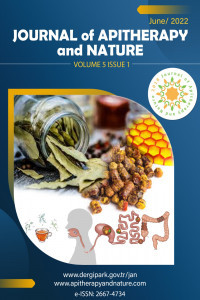Determination of Propolis Origin Using Phenolic Composition and Artificial Neural Networks
Determination of Propolis Origin Using Phenolic Composition and Artificial Neural Networks
___
- .
- Yayın Aralığı: Yılda 2 Sayı
- Başlangıç: 2018
- Yayıncı: Oktay YILDIZ
Erzsébet-timea DOMOKOS, Adriana URCAN, Liviu Alexandru MARGITAS, Daniel Severus DEZMIREAN, Otilia BOBIS
Antioxidant Activities of Propolis from Aragón (Spain)
M. Teresa SANCHO, Sandra M. OSÉS, Andrea RODRÍGUEZ-FERNÁNDEZ, Miguel A. FERNÁNDEZ-MUIÑO, Consuelo PÉREZ-ARQUILLUÉ, Regina LÁZARO, Susana BAYARRI
The Immune Modulatory and Anti-protozoal Effects of Different Propolis Samples
David G. WATSON, Harry de KONING, Godwin EBILOMA, John IgoLI, Weam SIHERI, Naif ALENZI, Samyah ALANAZI, Sameah ALENEZI, William HARNETT
Muhammad IQBAL, Tai-ping FAN, David WATSON, Sameah ALENEZI, Muhamad SAHLAN
M. B. GABRIEL, M. J. CARNEIRO, A. C. H. F. SAWAYA
Intestinal Morphology Broiler Chickens Supplemented with Propolis
Maja MISKULIN, İvana KLARIC, Matija DOMACINOVIC, Berislav PRAKATUR, Mirela PAVIC, Nika PAVLOVIC, İvan MISKULIN
Yoga Bee, a New Approach for Health
A Collaborative Study for Performance Evaluation of Analytical Methods for Propolis. An IHC Trial
M. LOPES, A. PEREYRA, C. KUNERT, G. BECKH, H. SCHREITER, O. G. ÇELEMLI, K. SORKUN, S GEORGÉ, L. PAULO, S. GARDINI, M.t SANCHO, V. BANKOVA, T. DASTAN, C. TANANAKI, L.f. NUNES, M. VILAS-BOAS
Quantitative and Qualitative Variations in Propolis Collection
C. TANANAKI, A. THRASYVOULOU, D. KANELIS, V. LIOLIOS
Propolis: Pharmacological Properties and Medical Applications of Propolis in Modern Medicine
